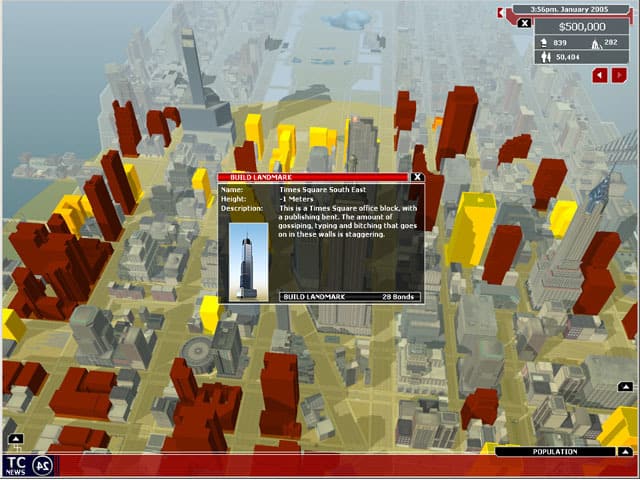You can trust VideoGamer. Our team of gaming experts spend hours testing and reviewing the latest games, to ensure you're reading the most comprehensive guide possible. Rest assured, all imagery and advice is unique and original. Check out how we test and review games here
Lately there’s been an advert on TV for a popular airline, claiming that they can even keep New Yorkers happy. It’s these very people who you’ve got to try and please in Tycoon City: New York, a strategy title from Atari and Deep Red Games (the developer behind such titles as Beach Life and SeaWorld Adventure Parks Tycoon). It’s a quite basic premise for a game: develop your own version of New York City. Of course, you’ll have to cater to the New Yorkers’ numerous demands, satisfying both the long-term home makers and the tourist industry, and all the while making enough cash in order to keep things ticking over.
To start you on your way, the road system is already firmly set in place, not allowing you the kind of freedom you’d expect, but I’ll ignore that for now. An introductory tutorial introduces you to the various gameplay techniques you’ll need to become accustomed to (with the aid of an on-screen character that’s voiced quite brilliantly), and soon you’re well on your way to becoming a high-flying multi-millionaire entrepreneur. Despite these lofty ambitions, it’s a task that’s not as tricky as you might think.
Each ‘zone’ of the city houses a particular type of local, each with their unique likes and dislikes. For example, in the student area of town, they make you very well aware that they like cheap clothes shops, coffee bars, and internet cafés aplenty. Finding out what people want couldn’t be simpler, either; all the info you need is never more than a mouse click away on the icon driven user interface. Simply click on the area you wish to develop, see what people want (shown by a series of horizontal bars, the length of which determines just how eager the people are to see more of the basic amenity), and with another two mouse clicks, you’ve placed the required building.
Each building has a ‘zone of influence’, affecting the surrounding area in various different ways. For example, a seedy nightclub isn’t going to go down too well with the locals if it’s placed right in the middle of modern suburbia, nor will placing a small bookshop in the middle of the night-life ridden portion of the city make good business sense. It’s an easy method to get your head around, and once you do you’ll be bringing in the cash in double-quick time.
Merely placing down these stores isn’t enough, however. Once a building is erected, you must then decide how to advertise and make the place more appealing to people in the local area. Billboards and huge store signs make the building more noticeable, but even placing a few extra chairs outside a café will improve its appeal, possibly making the difference between a steady little earner, and a spot where people regularly flock to get their daily latté.
But it’s here that the initial breaking up of Tycoon City: New York’s gaming experience occurs. If you do happen to place a store in the wrong kind of area, it’s not a case of finding yourself haemorrhaging money, but merely just not quite doing as well as you should. There’s no sense of ‘losing’ in the traditional gaming sense, merely a case of doing slightly less well than if you’d done exactly what the game itself suggested. There’s little to no room for manoeuvrability where buildings can truly be placed, because you know full well that if you don’t go for that ‘green spot’ you wont make as much cash as you know you should be making.
The emphasis on New York not only gives you the opportunity to see the city’s landmarks in your creation, but also the traditional parades that occur at Halloween and other times of the year. Thankfully the game engine, which allows you to zoom right out to a bird’s eye view of the city and zoom in close enough to hear what individual characters have to say, lets you witness these activities in their full glory. If there’s one thing that Tycoon City: New York does well, it’s providing a visual spectacle. Even aurally you’re treated to some of the best voice work ever heard in a game of this type, with characters that actually seem to talk like your typical ‘average Joe’ and not some over-the-top caricature of what us outside of New York perceive to be ‘normal’.
The over simplified nature of the game and its single-city nature is what ultimately causes most of the problems. The main draw of games like Sim City is the ability to design and build your very own city, from the tiniest little cottage, to the largest sky scraper, and every detail in-between. Creating your own city that grows and expands as you see fit, and hence, you develop a kind of connection with the area that you’ve built up. But here you’re not allowed that opportunity, with the game almost running the show for you.
Though the premise of developing and building your very own New York seems a fantastic idea, for those of us brought up with the freedom of the Sim City series, the restrictions are just too much to bear. It makes the entire concept seem like it’s pitched entirely at newcomers to the genre (which this may very well appeal to), stealing away the sheer pleasure that comes with designing and maintaining your very own city. If this is how to satisfy New Yorkers, they’re obviously not as hard to please as they’re claimed to be.






